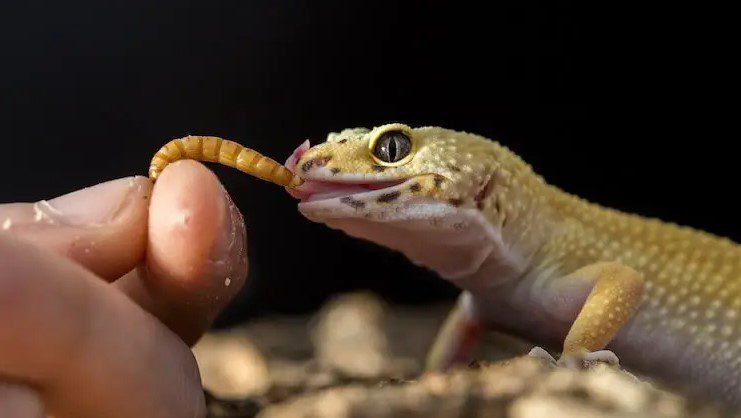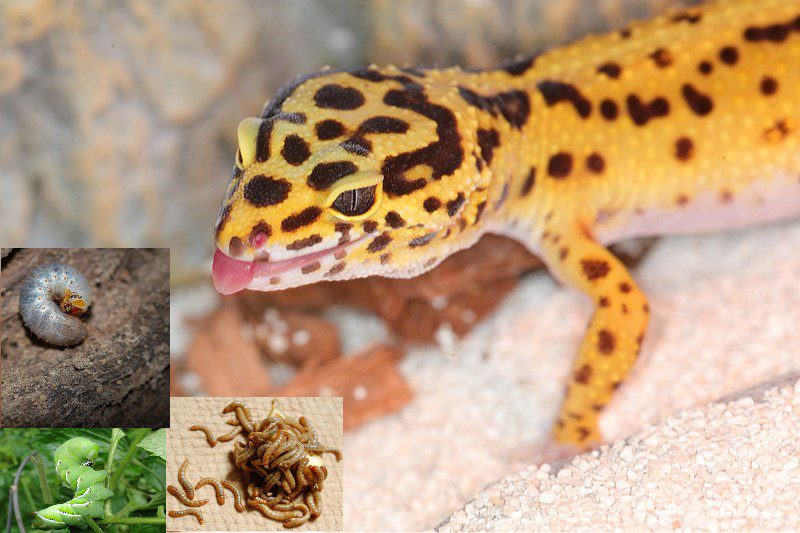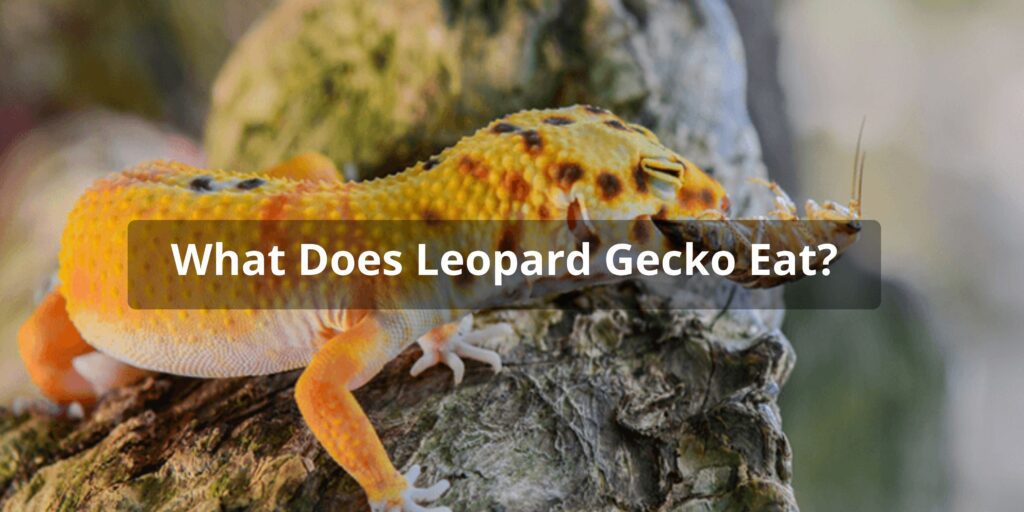Leopard geckos are fascinating reptiles known for their unique appearance and docile nature. To ensure the health and well-being of your leopard gecko, it is crucial to understand its dietary requirements. In this article, we will explore what leopard gecko diet, providing you with a comprehensive food list to meet their nutritional needs at every stage of life.
Leopard Gecko Feeding
Leopard geckos are predominantly insectivores, meaning their diet primarily consists of live insects. However, as they grow older, their diet tends to include a small portion of plant matter. It’s important to strike the right balance between these two food sources to maintain their optimal health.

Insect Food Ratio and Feeding Frequency
When it comes to feeding leopard geckos, the ratio of insect to plant-based food changes with age. Younger geckos require a higher proportion of insects in their diet, while older geckos can tolerate a slight increase in plant matter.
- Hatchlings (0-4 months): Hatchlings should be fed a diet consisting solely of live insects. Offer them appropriately-sized insects such as pinhead crickets or fruit flies. Feed them daily, providing as much food as they can consume within 15 minutes.
- Juveniles (4-12 months): During this stage, you can introduce a small amount of plant-based food into their diet. Continue offering live insects regularly but add occasional small portions of safe vegetables and fruits to their meals. Feed them every other day.
- Adults (12+ months): Adult leopard geckos can have a diet comprising around 80% insects and 20% plant matter. Provide a variety of live insects, along with larger quantities of vegetables and limited amounts of fruit. Feed them every two to three days.
What do Leopard Gecko diet?
Live Food
Leopard geckos thrive on a diet of live insects, which provide essential protein and nutrients. Here is a list of some commonly available live food options suitable for leopard geckos:
- Crickets (gut-loaded for optimal nutrition)
- Mealworms
- Dubia roaches
- Waxworms (occasional treat due to their high-fat content)
- Phoenix worms
- Silkworms
- Superworms (limited quantity due to their tough exoskeleton)
- Butterworms
These are just a few examples, and there are other suitable insect options available in the market. Remember to always purchase from reputable sources or breed them yourself to ensure their quality and health.
Vegetables
As leopard geckos mature, they can benefit from small amounts of plant-based food. Here are some safe vegetables you can offer to your gecko:
- Carrots (shredded or finely chopped)
- Leafy greens (collard greens, dandelion greens, mustard greens)
- Squash (butternut, acorn)
- Bell peppers (remove seeds and membranes)
- Zucchini
- Cucumber (peeled)
These vegetables provide additional vitamins and fiber to your gecko’s diet. Remember to chop them into appropriately-sized pieces to avoid choking hazards.
Fruit
While fruits should be given sparingly due to their high sugar content, they can be offered as occasional treats. Here are some safe fruit options for your leopard gecko:
- Papaya
- Mango
- Blueberries (cut into small pieces)
- Apples (remove seeds and core)
- Figs (dried figs should be rehydrated before feeding)
Ensure that any fruits offered are fresh and ripe. Remove uneaten fruit after a short period to prevent spoilage and potential health issues.
Vitamins & Minerals
To ensure your leopard gecko receives all the necessary vitamins and minerals, it is advisable to use reptile-specific multivitamin and mineral supplements. These should be dusted onto their live food before feeding, following the instructions provided by the manufacturer. Calcium supplementation is particularly crucial for proper bone development in growing geckos.
What Can’t They Eat?
While leopard geckos have a relatively wide range of food options, some items should be excluded from their diet due to potential health risks. Here is a list of foods you should avoid to your Leopard Gecko diet
- Toxic insects (fireflies, spiders, ants)
- Beetles (such as ladybugs or beetles found in the wild)
- Citrus fruits (oranges, lemons, grapefruits) due to their acidity
- Avocado (toxic to many reptiles)
- Rhubarb leaves (contain oxalic acid)
- Onions and garlic (known to be toxic to reptiles)
It’s important to research any new food items thoroughly before offering them to your leopard gecko diet. When in doubt, consult a reptile veterinarian for guidanceon the suitability of certain foods.
Rules and Tips for Feeding Leopard Gecko Diet

Feeding your leopard gecko requires attention to detail and adherence to certain guidelines. Here are some essential rules and tips to keep in mind:
- Size matters: Ensure that the size of the live insects you offer is appropriate for your gecko’s age and size. Prey items should be no larger than the width of their heads to prevent choking or digestive issues.
- Variety is key: Provide a diverse range of insect species to offer a balanced diet and prevent nutritional deficiencies. Different insects have varying nutrient profiles, so mixing them up ensures your gecko receives a wide array of essential nutrients.
- Gut-loading for nutrition: Before offering live insects to your leopard gecko, gut-load them with nutritious foods. This involves feeding the insects high-quality vegetables, grains, and commercial gut-loading supplements to enhance their nutritional content.
- Dusting with supplements: Dusting live insects with calcium and vitamin D3 supplements is crucial for maintaining proper bone health. Calcium deficiency can lead to metabolic bone disease, a common issue in captive reptiles. Follow the instructions provided by the supplement manufacturer for the correct dosage and frequency.
- Observe feeding behavior: Pay attention to your gecko’s feeding habits to ensure they are consuming an adequate amount of food. If you notice a decline in appetite or weight loss, consult a veterinarian to rule out any underlying health issues.
- Maintain cleanliness: Remove uneaten insects and spoiled fruit or vegetables from your gecko’s enclosure promptly. This prevents the growth of harmful bacteria and maintains a clean and hygienic environment for your pet.
How about water?
Leopard geckos obtain most of their hydration from their food sources. However, it is still crucial to provide them with a shallow bowl of fresh, clean water at all times. Make sure the water dish is easily accessible and large enough for your gecko to soak in if desired. Monitor the water level daily and clean and refill the bowl regularly to prevent bacterial growth.
Conclusion
Understanding the dietary requirements of leopard geckos is vital for their overall health and well-being. By providing a suitable balance of live insects, vegetables, and occasional fruits, you can ensure that your gecko receives the necessary nutrients for optimal growth and vitality. Remember to follow the feeding guidelines based on your gecko’s age and size, and consult a reptile veterinarian if you have any concerns or questions.
FAQs about What Does Leopard Gecko Eat
How often should I feed my leopard gecko?
Young leopard geckos should be fed daily to support their growth, while adults can be fed every other day or every few days to maintain their health. Adjusting feeding frequency based on age and size is important to prevent overfeeding or underfeeding.
What insects are suitable for leopard geckos?
Leopard geckos can eat a variety of insects including crickets, mealworms, dubia roaches, and waxworms. These insects provide essential protein and nutrients. It’s important to gut-load and dust them with calcium and vitamins before feeding.
Can I feed my leopard gecko wild-caught insects?
It’s safer to feed captive-bred insects to your leopard gecko rather than wild-caught ones. Wild-caught insects might carry parasites or pesticides that can be harmful to your gecko’s health. Opt for commercially bred insects to ensure their well-being.
Is it necessary to dust insects with supplements?
Yes, dusting insects with calcium and vitamin supplements is crucial for maintaining leopard geckos’ health. Calcium is essential for their bone development and muscle function. Proper supplementation helps prevent metabolic bone disease and other deficiencies.
What is the role of calcium in their diet?
Calcium plays a vital role in leopard geckos’ bone health, nerve function, and blood clotting. Since they have high calcium requirements, providing proper supplementation through dusted insects is essential to prevent potential health issues.
Can I offer live or pre-killed insects?
Leopard geckos can consume both live and pre-killed insects. However, pre-killed insects can be safer, especially for young or inexperienced geckos. Live prey might pose a risk of injury, while pre-killed insects eliminate this concern.
Are there insects that should be avoided?
Insects with hard exoskeletons, like superworms, can be difficult for leopard geckos to digest and might lead to health issues. Also, avoid feeding them wild-caught insects due to the potential presence of pesticides or parasites.
How can I encourage a balanced diet?
To promote a balanced diet for your leopard gecko, offer a variety of insect types and sizes. Replicating their natural feeding habits as closely as possible, along with proper supplementation, ensures they receive the necessary nutrients for their well-being.



